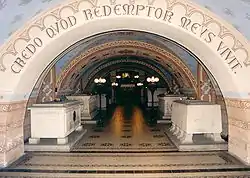Skałka
Saint Michael the Archangel and Saint Stanislaus the Bishop and Martyr Basilica, also known as Skałka, which means "a small rock" in Polish, is a small outcrop in Kraków atop of which a Pauline monastery is located.


%252C_15_Ska%C5%82eczna_street%252C_Kazimierz%252C_Krakow%252C_Poland.jpg.webp)

.jpg.webp)
It is said to be the place where the Bishop of Kraków saint Stanislaus of Szczepanów was slain by order of Polish king Bolesław II the Bold in 1079. This action resulted in the king's exile and the eventual canonization of the slain bishop.[1]
History
Located on the Vistula River south of Wawel, Skałka was part of the island city of Kazimierz until the nineteenth century, when the Old Vistula River was filled in.
The original church was built in the Romanesque style. King Casimir III replaced it with a Gothic church, and since 1472 that shrine has been in the possession of a monastic community of Pauline Fathers. In 1733-51 the church received a Baroque decor. It is one of the most famous Polish sanctuaries.
The Pauline "Church on the Rock" is primarily associated with the martyrdom of Saint Stanisław of Szczepanów. Each newly elected King of Poland made a pilgrimage to Skałka on the eve of his coronation as penance for the disgraceful action of his predecessor who had personally killed St. Stanisław.[2]
Interior
The crypt underneath the church serves as one of Poland's "National Panthéons" (alongside the Wawel Cathedral, St. John's Archcathedral and the Church of Saint Peter and Paul), a burial place for some of the most distinguished Poles, particularly those who lived in Kraków.[3]
- Jan Długosz (1415–1480), diplomat and historian
- Wincenty Pol (1807–1872), poet, geographer and freedom fighter
- Lucjan Siemieński (1809–1877), poet, writer and freedom fighter
- Józef Ignacy Kraszewski (1812–1887), writer and historian
- Teofil Lenartowicz (1822–1893), poet and sculptor
- Adam Asnyk (1838–1897), poet, playwright and freedom fighter
- Henryk Siemiradzki (1843–1902), painter
- Stanisław Wyspiański (1869–1907) poet, playwright and painter
- Jacek Malczewski (1854–1929), painter
- Karol Szymanowski (1882–1937), composer and pianist
- Ludwik Solski (1855–1954), theatre actor and director
- Tadeusz Banachiewicz (1882–1954), astronomer and mathematician
- Czesław Miłosz (1911–2004), poet and essayist, Nobel Prize recipient
Exterior
Outside the church is the Well of Saint Stanislaus. According to legend, this well is where King Bolesław discarded the bishop's dismembered body, which then miraculously reassembled. Water from the well is dispensed from a fountain for pilgrims to drink.[4]
In 2008, the Pauline fathers added the open-air Altar of the Three Millennia, with statues representing seven important people in Polish history.[5]
- Augustyn Kordecki (1603–1673), prior of Jasna Góra Monastery during the Siege of Jasna Góra
- Jadwiga of Poland (1374-1399), first female monarch of the Kingdom of Poland
- Adalbert of Prague (956-997), bishop of Prague and martyr
- Stanislaus of Szczepanów (1030-1079), bishop of Kraków and martyr
- Pope John Paul II (1920-2005), archbishop of Kraków, elected Pope in 1978
- Faustina Kowalska (1905-1938), nun whose mystical revelations inspired the Divine Mercy devotion
- Jan Kanty (1390-1473), priest and professor of philosophy and theology at the Kraków Academy
Six of these people (the exception being Kordecki) are venerated as saints in the Catholic Church.
See also
External links
References
- "Kościół na Skałce". Retrieved 2020-03-01.
- "Pauline Church on the Rock". Krakow.wiki. 2017-03-27. Retrieved 2019-04-25.
- "Kraków Panteon Narodowy w krypcie na Skałce". Retrieved 2020-03-01.
- "Miracle water Krakow – St. Stanislaus well – Polish Language, History and Culture".
- Weigel, George. City of Saints. IMAGE Press, 2015, p. 150.